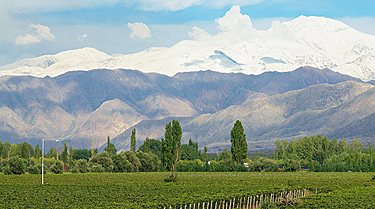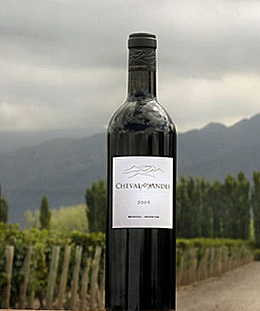

International (Country Appellation)
It’s the perfect moment for Argentina
At least for their well-made, well-priced wines.
by
Alan Goldfarb
May 5, 2009
 T can’t be just the thin air in the high-altitude Andes here in Mendoza, Argentina that’s uncluttering my brain and leading me to conclude: May Day, May Day Norte America, the Argentines are coming and coming fast. Hide the women and children and take cover because not only is Argentine wine inexpensive, I think now it is producing the best value wines in the world.
T can’t be just the thin air in the high-altitude Andes here in Mendoza, Argentina that’s uncluttering my brain and leading me to conclude: May Day, May Day Norte America, the Argentines are coming and coming fast. Hide the women and children and take cover because not only is Argentine wine inexpensive, I think now it is producing the best value wines in the world.
I can say that without equivocation after tasting some 100 wines from the Uco Valley, Luján de Cuyo, and Salta, three of the more prominent appellations in Argentina. And they aren’t all Malbec. Cabernet Sauvignon and Syrah are gaining ground. Even Bonarda (Charbono) is producing some wonderfully fruity, smokey, and chocolate-flavored wines.
Then there’s Torrontés. The best are from the unheard-of altitudes (up to 9,000-feet, which are perhaps the highest vineyards in the world)
 in the Valle de Cafayete in northern Salta, and they are some of the most idiosyncratic wines around today. Wonderfully aromatic and redolent of lychee and peach, not unlike Gewürztraminers or some Rieslings, these Torrontés wines– with their sometimes startling richness and acidity – have a chance to emerge as some of the best white wines being made anywhere.
in the Valle de Cafayete in northern Salta, and they are some of the most idiosyncratic wines around today. Wonderfully aromatic and redolent of lychee and peach, not unlike Gewürztraminers or some Rieslings, these Torrontés wines– with their sometimes startling richness and acidity – have a chance to emerge as some of the best white wines being made anywhere.
And then there are the prices. In the States, Torrontés (while still in short supply, but growing) can be found for about $8, with the best running around 15 bucks. The reds too are in the same price category, with some of the best now creeping up to $30-40. There are also more than a handful now that sell from $45 to $100 in the U.S., which may be a testament to increasing quality, aggressive marketing, or what I trust is not just plain hubris.
But with the peso being what it is against the U.S. dollar (about 3.70 at this writing), it’s quite common to find any of these wines in Buenos Aires restaurants at from only $10 to $20.
Uniformly, the wines are well-balanced, with lovely, fresh fruitiness, approachable tannin levels, and a goodly wash of acidity; and they are complex due to the mineral qualities of the thin, disease-resistant soils in which they are grown, and from a definitive terroir contribution from the omnipresent monoliths that are the Andes Mountains.
While almost every wine-growing region in the world has its terroir defined and nurtured by the proximity to an ocean or to a major river, Argentina’s wine regions – chiefly in the western part of the country and in the desert – are virtually land-locked. The run-off from the mountains feeds into the Rio Mendoza and several other rivers throughout the region, but these rivers run nearly dry during the growing season from November to May, and have been log-jammed to feed the intricate water systems that meander under the cities.
Thus in Argentina, the Andes are all.
The Andes’ peaks, as high as 22,000 feet, effectively block any influence from the Pacific Ocean hundreds of miles to the west on Chile’s border. But what they offer is a diurnal temperature range that is among the widest in the winegrowing universe. Warm, dry air is prevalent during the day, while a cool, snow-cap-influenced isothermal layer moves in at night to keep the grapes from raisin-ing. (The vineyards in the eastern part of Mendoza province, and therefore farthest from the mountains, are much warmer, not unlike those in the Central Valley of California.)
(The vineyards in the eastern part of Mendoza province, and therefore farthest from the mountains, are much warmer, not unlike those in the Central Valley of California.)
Nicolas Audebert, the winemaker and manager at Cheval des Andes, Cheval Blanc’s Argentine property, has a good take on the effect of the Andes’ ubiquity on his vineyard’s terroir. “The mountain is playing like the ocean,” he states from the very modern hospitality deck of the winery, as I stare in wonder at a 20,000-foot glacier on the horizon that I can practically touch. “When the sun goes down, you get that coolness from the mountains. It’s always windy and there’s 325 days of sun.”
Audebert has been here four years, the last 2½ at Cheval tending its 50 hectares (125 acres) that is planted to all five red Bordeaux varieties, with an even distribution (45 percent each) between Malbec and Cabernet, from which he makes one wine. Because, as he states in a thick French accent: “At Cheval (as in Bordeaux), it’s all about blends.”
He acknowledges that, at this juncture, and in order to present a face to the rest of the world, “Malbec is Argentina”. And he’s pleased that “Argentina is showing Malbec to the world.” But “the other way is blending,” which is what he does and what he hopes will expand Argentina’s horizons. “Argentina is about to grow and make amazing wine (outside of Malbec),” he declares.
He may be right. In my two weeks in the country, and after speaking to a half-dozen producers, it’s my observation that, at this very moment, there’s a perfect storm for Argentina to make great strides toward becoming a major player in the world of wine. If one considers that the rest of the world is floundering, trying to figure out how to extricate itself from under the economic morass, Argentina is poised to emerge perhaps sooner than most in terms of wine and tourism.
 For Norte Americanos, the time is right now to visit Argentina. Buenos Aires is beautiful, reminiscent of Europe and most especially of Barcelona, despite the fact that most Argentines will tell you chauvinistically and vaingloriously that BA is like Paris.
For Norte Americanos, the time is right now to visit Argentina. Buenos Aires is beautiful, reminiscent of Europe and most especially of Barcelona, despite the fact that most Argentines will tell you chauvinistically and vaingloriously that BA is like Paris.
The dollar is very strong against the peso (and where in the world can you say as much?). A good dinner will set one back only about $25 a person – with wine; and there’s more than just beef, and more than merely Malbec. And those Malbecs and Cabs and Syrahs, and Torrontés are wines of world-class quality, and some of the greatest values in the world. And that is perfecto as the porteños, which is how the people of Buenos Aires refer to themselves, like to say.
Photo by © Jomar Brustolin










 READER FEEDBACK: To post your comments on this story,
READER FEEDBACK: To post your comments on this story,





